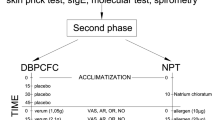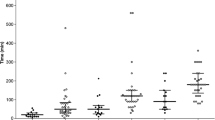Abstract
Purpose
Lysozyme, obtained from egg white, is a potential food allergen used in the dairy industry to prevent late blowing of the loaf caused by the outgrowth of clostridial spores (Cl. butyricum and Cl. tyrobutyricum) during cheese aging. The aim of this study was to evaluate the possible correlation between egg protein allergy in pediatric age and sensitization to egg lysozyme, used for the preparation of Grana Padano cheese.
Methods
The tolerability of Grana Padano cheese has been evaluated in pediatric patients allergic to egg proteins through an oral provocation test with increasing amounts of cheese containing, or not, lysozyme at 12 and 24 months of aging.
Results
When lysozyme-sensitized children received 12-months aged and lysozyme-containing cheese, several immediate and late adverse reactions such as itching, abdominal pain, vomiting, nausea, dermatitis, rhinitis, bronchial asthma, urticaria, and angioedema were seen in 5 out of 21 subjects; only 1 out of 21 children showed an adverse reaction after challenge with 24-months-ripened lysozyme-containing cheese.
Conclusions
There is a possible relationship between the severity of allergic reactions and the lysozyme-specific IgE level in blood. In particular vomiting, hypotension, and abdominal pain were present when IgE level was higher than 7 kU/L. A ripening time of 24 months may reduce allergy problems when lysozyme-containing cheese is given to sensitized subjects, probably due to the hydrolysis of antigenic epitopes during aging.
Similar content being viewed by others
References
Poulsen LK, Hansen TK, Nirgaard A, Vestergaard H, Stahl Skov P, Bindslev-Jensen C (2001) Allergens from fish and egg. Allergy 56(Suppl 67):39–42
Aabin B, Poulsen LK, Ebbehøj K, Nørgaard A, Frøkiaer H, Bindslev-Jensen C, Barkholt V (1996) Identification of IgE-binding egg white proteins: comparison of results obtained by different methods. Int Arch Allergy Immunol 109:50–57
Teufel M, Biedermann T, Rapps N, Hausteiner C, Hanningsen P, Enck P, Zipfel S (2007) Psychological burden of food allergy. World J Gastroenterol 13:3456–3465
Poulsen FM, Hoch JC, Dobson CM (1980) A structural study of the hydrophobic box region of lysozyme in solution using nuclear overhauser effects. Biochemistry 19:2597–2607
FAO/WHO (1992) Evaluation of certain food additives. 39th report of Joint FAO/WHO Expert Committee, Geneva
Klijn N, Nieuwenhof FFJ, Hoolwerf JD, Van Der Waals CB, Weerkamp AH (1995) Identification of Clostridium tyrobutyricum as the causative agent of late blowing in cheese by species-specific PCR amplification. Appl Environ Microbiol 61:2919–2924
Fuglsang CC, Johansen C, Christgau S, Adler-Nissen J (1995) Antimicrobial enzymes: applications and future potential in the food industry. Trends Food Sci Technol 6:390–396
Bester BH, Lombard SH (1990) Influence of lysozyme on selected bacteria associated with Gouda cheese. J Food Prot 53:306–311
Anet J, Back JF, Baker RS, Barnett D, Burley RW, Howden MEH (1985) Allergens in the white and yolk of hen’s egg. Study of IgE binding by egg proteins. Int Arch Allergy Immunology 77:364–371
Iaconelli A, Fiorentini L, Bruschi S, Rossi F, Mingrone G, Piva G (2008) Absence of allergic reactions to egg white lysozyme additive in Grana Padano cheese. J Am Coll Nutr 27:326–331
Frémont S, Kanny G, Nicolas JP, Moneret-Vautrin DA (1997) Prevalence of lysozyme sensitization in an egg-allergic population. Allergy 52:224–228
Rona RJ, Keil T, Summers C, Gislason D, Zuidmeer L, Sodergren E et al (2007) The prevalence of food allergy: a meta-analysis. J Allergy Clin Immunol 120:638–646
Sicherer SH (2011) Epidemiology of food allergy. J Allergy Clin Immunol 127:594–602
Ferrari G, De Amici M, Notarangelo LD, Monafo V, Burgio GR (1989) RAST positivity for food in atopic dermatitis. Minerva Pediatr 41:137–141
Sampson HA (2001) Utility of food-specific IgE concentrations in predicting symptomatic food allergy. J Allergy Clin Immunol 107:891–896
Naila A, Flint S, Bremer P, Meerdink G (2010) Control of biogenic amines in food-existing and emerging approach. J Food Sci 75:R139–R150
Maintz L, Novak N (2007) Histamine and histamine intolerance. Am J Clin Nutr 85:1185–1196
Jacobsen B, Hoffmann-Sommergruber K, Thordahl Have T, Foss N, Briza P, Oberhuber C, Radauer C, Alessandri S, Knulst AC, Fernandez-Rivas M, Barkholt V (2008) The panel of egg allergens, Gal d 1–Gal d 5: their improved purification and characterization. Mol Nutr Food Res 52:S176–S185
Walsh BJ, Hill DJ, Macoun P, Cairns D, Howden MEH (2005) Detection of four distinct groups of hen egg allergens binding IgE in the sera of children with egg allergy. Allergol Immunopathol 33:183–191
Sampson HA, Ho DG (1997) Relationship between food-specific Ig E concentrations and the risk of positive food challenges in children and adolescents. J Allergy Clin Immunol 100:444–451
Celik-Bilgili S, Mehl A, Verstege A, Staden U, Nocon M, Beyer K et al (2005) The predictive value of specific immunoglobulin E levels in serum for the outcome of oral food challenges. Clin Exp Allergy 35:247–249
Boyano-Martinèz T, Garcia-Ara C, Diaz-Pena JM, Muñoz FM, Garcìa-Sànchez G, Martin-Esteban M (2001) Validity of specific Ig E antibodies in children with egg allergy. Clin Exp Allergy 31:1464–1469
Besler M, Steinhart H, Pascke A (2000) Allergens of animal origin: stability and allergenicity of processed food. Internet Symp Food Allerg 2(4):171–184
Schneider N, Werkmeister K, Becker CM, Pischetsrieder M (2011) Prevalence and stability of lysozyme in cheese. Food Chem 128:145–151
Atassi MZ, Lee CL (1978) The precise and entire antigenic structure of native lysozyme. Biochem J 171:429–434
Padlan EA, Silverton EW, Sheriff S, Cohen GH, Smith-Gill SJ, Davies DR (1989) Structure of an antibody-antigen complex: crystal structure of the HyHEL-10 Fab-lysozyme complex. Proc Natl Acad Sci 86:5938–5942
Sheriff S, Silverton EW, Padlan EA, Cohen GH, Smith-Gill SJ, Finzel BC, Davies DR (1987) Three-dimensional structure of an antibody-antigen complex. Proc Natl Acad Sci 84:8075–8079
Acknowledgments
This research was supported by Grana Padano Protection Consortium and Fordras S.A.
Author information
Authors and Affiliations
Corresponding author
Rights and permissions
About this article
Cite this article
Marseglia, A., Castellazzi, A.M., Valsecchi, C. et al. Outcome of oral provocation test in egg-sensitive children receiving semi-fat hard cheese Grana Padano PDO (protected designation of origin) containing, or not, lysozyme. Eur J Nutr 52, 877–883 (2013). https://doi.org/10.1007/s00394-012-0394-5
Received:
Accepted:
Published:
Issue Date:
DOI: https://doi.org/10.1007/s00394-012-0394-5




